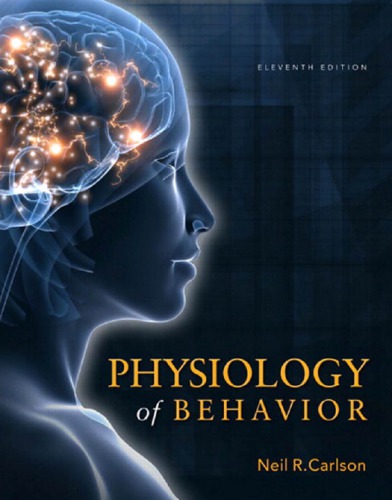

Most ebook files are in PDF format, so you can easily read them using various software such as Foxit Reader or directly on the Google Chrome browser.
Some ebook files are released by publishers in other formats such as .awz, .mobi, .epub, .fb2, etc. You may need to install specific software to read these formats on mobile/PC, such as Calibre.
Please read the tutorial at this link. https://ebooknice.com/page/post?id=faq
We offer FREE conversion to the popular formats you request; however, this may take some time. Therefore, right after payment, please email us, and we will try to provide the service as quickly as possible.
For some exceptional file formats or broken links (if any), please refrain from opening any disputes. Instead, email us first, and we will try to assist within a maximum of 6 hours.
EbookNice Team

Status:
Available0.0
0 reviews
ISBN 10: 0205239390
ISBN 13: 9780205239399
Author: Neil R Carlson
The most current, comprehensive, and teachable text for biological psychology
Thoughtfully organized, Physiology of Behavior provides a scholarly yet accessible portrait of the dynamic interaction between biology and behavior. Close collaboration between the author and a talented artist has resulted in beautiful, accurate, and pedagogically effective illustrations in every chapter.
No other author compares to Carlson when it comes to thoroughly updating research. This revision incorporates the latest discoveries in biological psychology, and includes over 400 new references. Integrated for the first time with the new MyPsychLab and the Virtual Brain, the 11 edition offers students an immersive and engaging multi-media experience.
A better teaching and learning experience
This program will provide a better teaching and learning experience– for you and your students. Here’s how:
Note: MyPsychLab does not come automatically packaged with this text. To purchase MyPsychLab, please visit www.mypsychlab.com or you can purchase a la carte version of the text + MyPsychLab. ISBN-10: 0205240100 / ISBN-13: 9780205240104
This Books a la Carte Edition is an unbound, three-holed punched, loose-leaf version of the textbook and provides students the opportunity to personalize their book by incorporating their own notes and taking only the portion of the book they need to class — all at a fraction of the bound book price.
Part 1: Foundations of Behavioral Neuroscience
Introduction
Understanding Human Consciousness: A Physiological Approach
The Nature of Physiological Psychology
Natural Selection and Evolution
Ethical Issues in Research with Animals
Careers in Neuroscience
Strategies for Learning
Structure and Functions of Cells of the Nervous System
Cells of the Nervous System
Communication within a Neuron
Communication between Neurons
Structure of the Nervous System
Basic Features of the Nervous System
The Central Nervous System
The Peripheral Nervous System
Psychopharmacology
Principles of Psychopharmacology
Sites of Drug Action
Neurotransmitters and Neuromodulators
Methods and Strategies of Research
Experimental Ablation
Recording and Stimulating Neural Activity
Neurochemical Methods
Genetic Methods
Part 2: Inputs and Outputs That Guide Behavior
Vision
The Stimulus
Anatomy of the Visual System
Coding of Visual Information in the Retina
Analysis of Visual Information: Role of the Striate Cortex
Analysis of Visual Information: Role of the Visual Association Cortex
Audition, the Body Senses, and the Chemical Senses
Audition
Vestibular System
Somatosenses
Gustation
Olfaction
Control of Movement
Muscles
Reflexive Control of Movement
Control of Movement by the Brain
Part 3: Classes of Species-Typical Behavior
Sleep and Biological Rhythms
A Physiological and Behavioral Description of Sleep
Disorders of Sleep
Why Do We Sleep?
Physiological Mechanisms of Sleep and Waking
Biological Clocks
Reproductive Behavior
Sexual Development
Hormonal Control of Sexual Behavior
Neural Control of Sexual Behavior
Parental Behavior
Emotion
Emotions as Response Patterns
Communication of Emotions
Feelings of Emotions
Ingestive Behavior
Physiological Regulatory Mechanisms
Drinking
Eating: Some Facts about Metabolism
What Starts a Meal?
What Stops a Meal?
Brain Mechanisms
Obesity
Anorexia Nervosa/Bulimia Nervosa
Learning and Memory
The Nature of Learning
Synaptic Plasticity: Long-Term Potentiation and Long-Term Depression
Perceptual Learning
Classical Conditioning
Instrumental Conditioning
Relational Learning
Human Communication
Speech Production and Comprehension: Brain Mechanisms
Disorders of Reading and Writing
Part 4: Neurological and Psychiatric Disorders
Neurological Disorders
Tumors
Seizure Disorders
Cerebrovascular Accidents
Disorders of Development
Degenerative Disorders
Disorders Caused by Infectious Diseases
Schizophrenia and the Affective Disorders
Schizophrenia
Major Affective Disorders
Anxiety Disorders, Autistic Disorder, Attention-Deficit/Hyperactivity Disorder, and Stress Disorders
Anxiety Disorders
Autistic Disorder
Attention-Deficit/Hyperactivity Disorder
Stress Disorders
Drug Abuse
Common Features of Addiction
Commonly Abused Drugs
Heredity and Drug Abuse
Therapy for Drug Abuse
physiology of behavior ebook
human behavior physiology
physiology textbook high school
physiology textbook online
history of behaviorism
history of behaviorism timeline
Tags: Neil R Carlson, Physiology, behavior